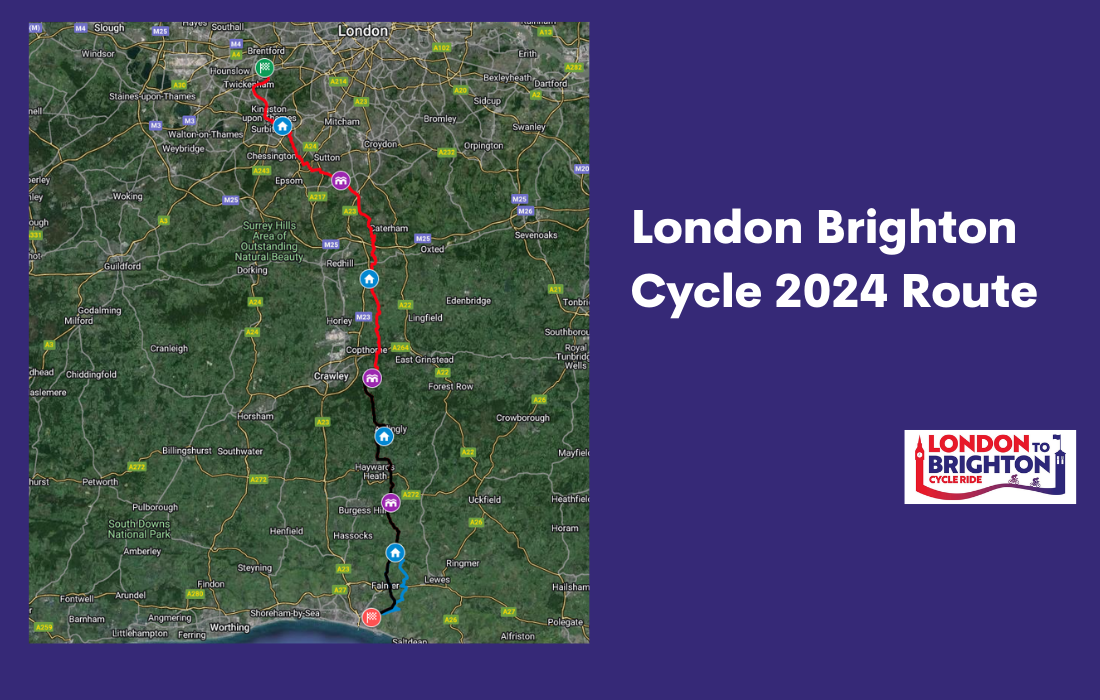Differences between the RideLondon & London Brighton Cycle routes? RideLondon 2024 and London Brighton Cycle 2024 are two of the biggest cycling events to take place in the South of England. Cycling enthusiasts from up and down the country and throughout Europe will flock to these events to help raise money and awareness for their chosen charities.
Charity cycles are not just about raising money for good causes. They are also essential for driving an interest in physical fitness and fostering community engagement along the routes. Whether you are taking part in the event or cheering from the sidelines, there are plenty of reasons to get excited about these two cycling events taking place in 2024.
In this guide, we’re going to explore the differences between the two routes and what you can expect along the way. We’ll also explore some of the challenges cyclists will face and how they can overcome these challenges to ensure they have an enjoyable time, no matter which event they choose.
RideLondon 2024 Route
RideLondon 2024 will take place on Sunday 26 May 2024, allowing cyclists of all abilities to take part in a long-distance cycling challenge on car-free roads. It costs between £32 and £99, depending on the distance you choose. In 2023, the event attracted over 25,000 participants and the event has raised over £83 million since it started 10 years ago.
RideLondon 2024 recently announced that they have secured their route for the next three years. This is exciting news for cyclists who love to take part in long-distance challenges. The RideLondon 2024 event is split into three different categories, with participants able to choose between a 30-mile, 50-mile or 100-mile challenge.
The general direction of the ride is into the Essex region, taking in impressive London landmarks along the way. As with most organised cycling events, there will be regular water stops and support for bicycle problems along the way.
The route is different depending on which length of challenge you choose. However, they all start and finish at the same point on the Victoria Embankment in central London. The RideLondon challenge is a circular route that heads northeast out of London into the Essex countryside and then circles around and returns to the starting point.
The RideLondon 30 route starts at Victoria Embankment, and then riders head through Stratford and up to beautiful Woodford before doubling back and ending at Tower Bridge.
The RideLondon 60 route starts at Victoria Embankment and then heads northeast through Stratford, up through Epping Forest, and through Ongar and Chigwell Row before returning to the same route at Woodford and doubling back towards Victoria Embankment.
The RideLondon 10 route also starts at Victoria Embankment and travels through Stratford and Epping Forest before heading deep into the Essex countryside, taking in villages such as Great Dunmow, Felsted and Chelmsford. Riders will then head towards Ongar and take a car-free route through Chigwell Row before heading back into Central London along the Thames and finishing at Victoria Embankment.
All of the RideLondon 30, 60 and 100-mile routes take place on the same day to help minimise disruption and to ensure maximum support for the riders. While there has been some resistance from local councils to the road closures, the event generally enjoys widespread support from locals.
London Brighton Cycle 2024 Route

The London Brighton Cycle 2024 will take place on Sunday 15th September 2024. This is the 15th anniversary of the iconic event. It costs £55 to secure a spot to take part and there are usually around 10,000 participants helping to raise money for charity. In 2023, over £1.4 million was raised for good causes including the British Heart Foundation.
As the name suggests, the London Brighton Cycle 2024 route starts in Clapham Common in Central London and takes riders on a challenging 55-mile cycle to the coastal town of Brighton. Starting south of the Thames, cyclists head due south on the route, passing through Mitcham, Carshalton, Chipstead, Banstead and Haywards Heath.
The big challenge of the route is a 1-mile climb to the top of Ditchling Beacon in the South Downs. At the top of the climb, riders will be met with stunning views and a much-needed water station. From there, it’s an easy ride into the centre of Brighton, where crowds will be looking on to cheer their achievement.
The good news is that some parts of the route will be car-free, and there will be plenty of support along the way, including water stations and mechanical support if you run into bike problems. The most important thing to consider when signing up for this event is how you will return to London or complete your onward journey. You can view it here on Google Maps.
Similarities between RideLondon and London Brighton Cycle routes
Both routes offer iconic start and end points, allowing you to soak up the sights of southern England from a unique vantage point. They are also similarly matched in terrain, making the challenge about the same.
According to Google Maps, the London to Brighton Cycle has an ascent of 2,774ft and a descent of 2,270ft. The RideLondon route is a little flat and doesn’t have the challenging mile-long climb up to the Ditchling Beacon. In general, cycling in the South of England is fairly level, and you won’t be facing the same uphill battles that might be seen on cycles in the North of England or Scotland.
In terms of length, the RideLondon 60-mile route is very similar to the London to Brighton Cycle. For this mid-length cycle, participants can expect to take between 3 and 5 hours to complete the journey, depending on their fitness and past experience. All riders should have some experience with long-distance cycles before signing up.
Another key similarity is the possibility of riding for your chosen charity. For many riders, this is a key part of the cycling challenge. If you have already signed up and secured your spot for either ride, you’ll have the option to select your own charity partner. If you’re looking for a spot, you can find charities with available rider spots and raise money for them.
Both rides are responsible for considerable fundraising efforts, and this remains a key objective of both RideLondon and London Brighton Cycle. Raising money for charity is an excellent way to make sure you are fully committed to the cause, and this will also help spur you on when you face challenges and doubts along the way.

Differences between the RideLondon and London Brighton Cycle routes
The main difference between the RideLondon and London Brighton Cycle routes is the possibility of choosing a different route length with RideLondon. However, the London Brighton Cycle offers a comfortable middle-ground distance that will challenge novice cyclists and provide a fun experience for more seasoned cyclists.
The London to Brighton Cycle has different start and end points, offering the unique challenge of cycling from one point to another. It’s fun to be able to say you’ve cycled the distance from one place to another, as it helps to put things into perspective when you share this information with other people.
Both routes take in the English countryside, but with the RideLondon route, you’ll head into Essex, while the London to Brighton Cycle will take you through Surrey and Mid Sussex. The terrain and views will be similar, offering a mixture of farmland and woodland. On the London Brighton Cycle, you’ll also cycle over the stunning South Downs, with chalk hills and rolling farmland.
What challenges will cyclists face?
As with any distance cycle, the biggest challenge cyclists will face is the physical challenge of staying energised and motivated for the entire route. Distance cycling is not something that people can enter without some significant training, and it should be treated like any other physical feat, such as a marathon or triathlon.
Both riding challenges offer cycling training plans to enable you to start building up to longer and longer distances, ensuring you are ready for the full distance on race day. This can be a fun aspect of long-distance cycling challenges that will also enable you to prioritise your health.
It’s vital for riders to make the most of the regular water points if they don’t have the means to carry enough water for the entire ride. Many cyclists will use backpacks with water bladders to help them stay hydrated for the duration, and you will also have the chance to stop and refill water bottles and bladders at strategic points in the cycle.
Cyclists also risk running into technical issues with long-distance cycle challenges. While you can certainly mitigate your risk and carry tools to address issues along the way, the race organisers can also help out. Both races offer technical support in the event you run into trouble.
Thankfully for participants, both courses are car-free, which means you can enjoy the freedom of road racing without the risk of a collision with a vehicle. However, it’s important to still take your safety seriously. Riders have to be over the age of 18 to participate, and riders aged 16 and 17 are able to take part if they register and ride with another adult.
Helmets are required to ensure your safety if you fall off your bike for any reason. Collisions with other cyclists are certainly possible, and there is also the risk of falling off your bike due to uneven road surfaces. An unexpected pothole could quickly derail your day and cause significant injuries if you aren’t wearing a helmet.

Preparing for the ride: what to expect and how to train
Whether you choose to take part in RideLondon 2024 or London Brighton Cycle 2024, you will need to start a rigorous training plan to prepare. First and foremost, make sure that your bike is up to the challenge and meets the event regulations. You need to make sure you have some experience riding your bike on roads before you head out, so don’t rely on gym-based stationary bike training alone.
If you are planning to complete a 55 to 60-mile bike ride, you should start with a comfortable distance of around 5 miles. This is your baseline training and will determine how quickly your training progresses. If you have a good level of cardiovascular fitness, you might be able to quickly progress to 30-mile training rides. If this is your first time doing any exercise for a while, keep repeating your 5-mile cycle until it feels more comfortable.
Nutrition is also an essential part of the training programme, and you need to learn how to fuel yourself on the go. You might need to experiment with training gels, glucose tablets and energy bars to determine which fuel source works best for you when you are exercising.
Hydration is also a key part of the equation. You might want to use a combination of plain water and electrolytes to replenish essential salts that are lost in sweat. To determine how much water you lose in sweat, you can conduct a 60-minute sweat test by weighing yourself before and after a 60-minute cycle. The difference in the two numbers should give you an indication of how much you sweat in ml per hour.
Closing thoughts
In conclusion, both RideLondon 2024 and London Brighton Cycle 2024 offer unique and exciting cycling experiences for enthusiasts and amateur cyclists alike. While the routes have their differences, they both provide an opportunity to raise money for important charities, promote physical fitness, and engage with local communities.
Ultimately, the choice between these two events will depend on individual preferences and goals, but either way, participants can expect a challenging and rewarding ride through some of the most scenic parts of southern England. If you’re really feeling up to the challenge, why not sign up for both events and challenge yourself. The 30-mile RideLondon 2024 challenge in May could be the ideal training event before completing the 55-mile London Brighton Cycle 2024 in September.





